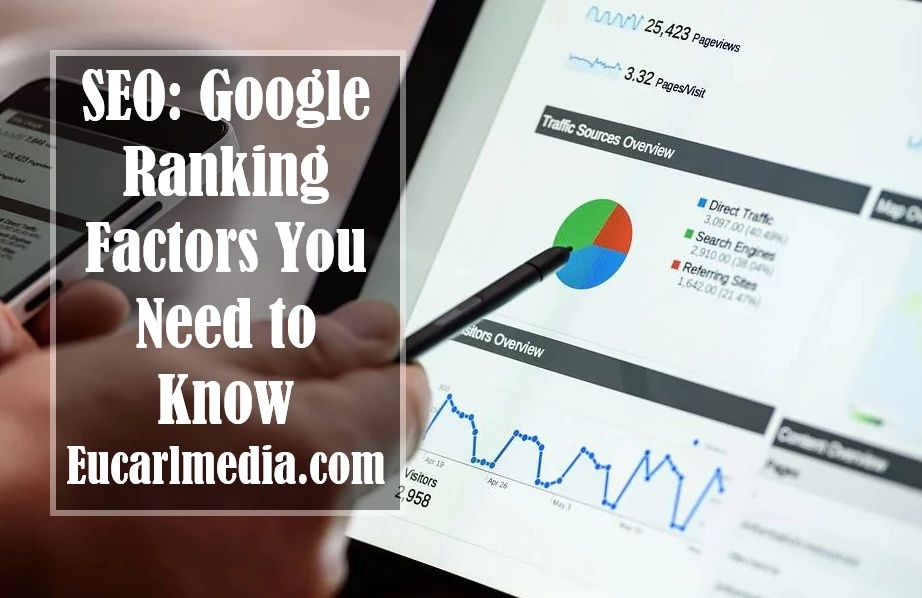SEO: 10 Google Ranking Factors You Need to Know
Learn about some of the main Google ranking factors and how they influence your website’s organic results. Ranking factors are criteria that Google takes into account to better organically position a website on the results page for a keyword search.
What is Google Ranking Factors? That’s the million-dollar question (it could be 10 or 100 million, depending on your business) when it comes to SEO. We give the answer for free: nobody knows for sure.
Well, the best we can do is analyze the results for thousands of keywords to (maybe) come to some kind of conclusion. But calm down, that doesn’t mean you need to do this; some specialized companies do this periodically, and we will reveal some to you.

What Is SEO?
SEO (search engine optimization) is the set of actions and strategies of Digital Marketing that aim to increase traffic and performance of a website through organic results from search engines such as Google, Bing, and even YouTube.
What is Google Ranking Factors?
Its been confirmed that there are more than 200 Google Ranking Factors that define which pages will be better positioned when you do a search. And it’s “you”, because today, with mobile devices, even your physical location influences which bakeries appear on SERP when you want to sit down for a coffee.
As a study by Search Metrics shows, Google Ranking Factors are increasingly personalized – both for users and companies. The search via mobile is also giving a mess on the scene. Therefore, the study itself reinforces that it is vital to understand these changes and invest time in what works.
So, in summary, Google Ranking Factors are criteria that Google takes into account to better organically position a website on the results page for a search on a particular keyword. Next, you’ll see (probably) what Google’s most important ranking factors are (perhaps). And not necessarily in the order presented (but maybe so).
Important Google Ranking Factors
Page Authority/Pagerank
Pagerank is a metric that dates back to the early days of Google, giving a rating from 0 to 10 for a page’s authority over a keyword. The rating, based mainly on the quality and quantity of links that the page receives, ceased to be public in 2016.
However, Google still uses Pagerank. After crying for a few days, SEO analysts looked for alternatives, such as Moz’s Page Authority. It also gives a score, but from 1 to 100, and takes other relevant Google Ranking Factors into account.
It is logarithmic, which means that as the number gets bigger, it gets harder to grow. Want to see how your page’s authority is doing? Use MozBar or Ubersuggest.
Domain Authority (DA)
Domain Authority is also metered by Moz or Ubersuggest and uses the same criteria to rate a page, but expands across the entire domain.
Our domain, for example, is https://eucarlmedia.com/, and all pages and subdirectories linked to it are evaluated by Google taking them into account. As in Page Authority, the grade ranges from 1 to 100, and the higher it is, the more authority of your domain.
Relevance of Links
“Oops, this item is easy, just fill my page with links to top sites !” Unfortunately, that’s not quite it. It actually refers to links on other sites to your page. The more you are referenced on other sites relevant to your business universe, the more Google will understand that your content is valuable and should be featured in the top positions.
You can be so good and creative that it will happen organically, but you can also adopt a link-building strategy. A cool way to do this is to build relationships with blogs from relevant companies that operate in markets that complement yours. Thus, you can exchange guest posts, generating links naturally to your site.
Original and Quality Content
First of all: never, under any circumstances, copy content from other websites. Not only does this not help you rank your site better, but it can also severely get you penalized. The best way to contemplate this factor is to put in place a good Content Marketing strategy. Quality content reinforces your authority in several ways.
In addition to helping you get the links mentioned in the previous item, they create an audience, as they will be useful to many people. Google values well-written text much more than something built just to insert keywords.
Content Size
This item is closely linked to the previous one. Think with me: the more relevant information about a subject, the more relevant the content as a whole will be, right? So there is no ideal number of words or characters for Google, but in general, the bigger the better. The general idea is that a smaller article will be more superficial than a larger one.
Makes sense, doesn’t it? This is not to say that you should stuff sausages, because, in addition to scaring readers right away because of its size, the reading experience will be unpleasant and will cause your content to be abandoned before the end. Another tip: explore synonyms.
Keyword in the Title (title tag)
The page title is one of the most important elements of on-page SEO. It is not necessarily the title of the article. It is rather a property of the HTML code, which you can see in your browser tab or on the Google results page.
The keyword has to be there, preferably right at the beginning. If your site is on WordPress, a tip is to install Yoast SEO. In it, you can easily edit this information, which will be very useful to help your site on Google. It has a free version that already handles a lot.
Keyword in Content
In addition to being in the title (and in your heart), it’s a good idea for the keyword to appear in the first 100 words. Also put in some subheads, always remembering not to push it. In fact, the subheads themselves help your page to rank better as they make the content more scannable.
In the past, there was a technique called keyword stuffing, which consisted of using the keyword a lot. This has not been indicated for a long time, it is even contraindicated. Yoast SEO, which we mentioned above, helps you to measure whether you are exaggerating or not. And again, learn more about semantic search and consider using synonyms.
Anyway, the keyword needs to occupy prominent spaces in your content, but that doesn’t mean you should build it just so it shines. Did you understand?
Length of Stay on Page
At this point in the tech world, you’ve probably gotten used to the fact that Google knows everything about you. Yes, everything. And you voluntarily gave this information. If it’s any consolation, almost all of humanity is in the same situation.
We are all doomed to a horrible end at the hands of machines, but I digress. One of the things Google knows is how much time you (and almost all of humanity) spend on a website. In general, you spend more time on sites whose content interests you, right? Okay, that doesn’t necessarily apply to social media.
Page Loading Speed
Your site should take a maximum of 2 seconds to load. After that, it starts being penalized by Google because it harms the user experience. We know that the quality of internet access is not the best in some countries, so remember this when building your website. There are a number of actions you can take to make your page the Usain Bolt of pages. Reducing the size of images and GIFs, for example, is one of them.
Read Also: Top 10 Tools To Measure Website Loading Speed
Responsive Design
Did you know that more than half of Google searches are done on mobile devices? Taking that into account, the search giant prioritizes sites that are responsive – which is different from having a mobile version. Responsive websites are those that, with the same layout and regardless of device, adjust to any resolution harmonically, giving the user the same reading experience. This also helps with loading speed.
Image Optimization
Search engines cannot see an image the way the human eye can. They only identify pixels, not being able to see clearly what each image is about. Therefore, it is important to signal to the robot what the image refers to and this can be done through the file name, alternative text, description, and caption.
This optimization, in addition to making your content more complete for the robot and making the page more accessible to users with visual impairments, can also contribute to a good placement on Google Images.
Recent and Content Updates
With the Google Caffeine update, newer content is now prioritized for display on the search engine results page. That’s why it’s always important to have current content on your website or blog, if you already have good content on a certain subject, it’s interesting to keep a routine to update it. You can add or remove paragraphs, embed multimedia files, update meta tag content, and so on.
Read Also: 10 Tips – What Every Content Creator Should Know
Multimedia Files
Taking advantage of the hook from the previous topic, multimedia files are also interpreted by Google as a sign of the quality of their content. After all, they bring more data options, interactivity, and content enrichment. You can use images, infographics, and videos, and provide the text content in audio format, in short, have complete freedom to create and enhance the most different formats in your text.
Usability
It’s no use having great content if your site’s usability is poor. As we know, Google always considers the user experience and prioritizes sites where there is fluid navigation. Therefore, sites with difficult navigation and high bounce rates end up underperforming in their positioning.
SSL Certificate
If you still don’t use the SSL certificate on your website, run now and go get yours! Google itself has already stated that it uses HTTPS as criteria for ranking the site, besides that we must agree that data and information security should be a priority for all of us.
Read Also: Before Starting a Blog, Some Facts Should Be Known
Conclusion
If you take these Google ranking factors into account, you’ll start seeing results soon. While it is not certain which are the most important ones, they will make a difference. Also, explore the links in the text to further explore the subject.





![How To Rank For Long-Tail Keywords: 5 Proven Ways ([year]) How To Rank For Long-Tail Keywords](https://eucarlmedia.com/wp-content/uploads/2023/07/20230728_154607-768x512.webp)
